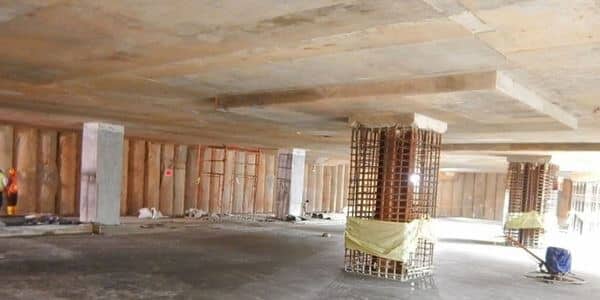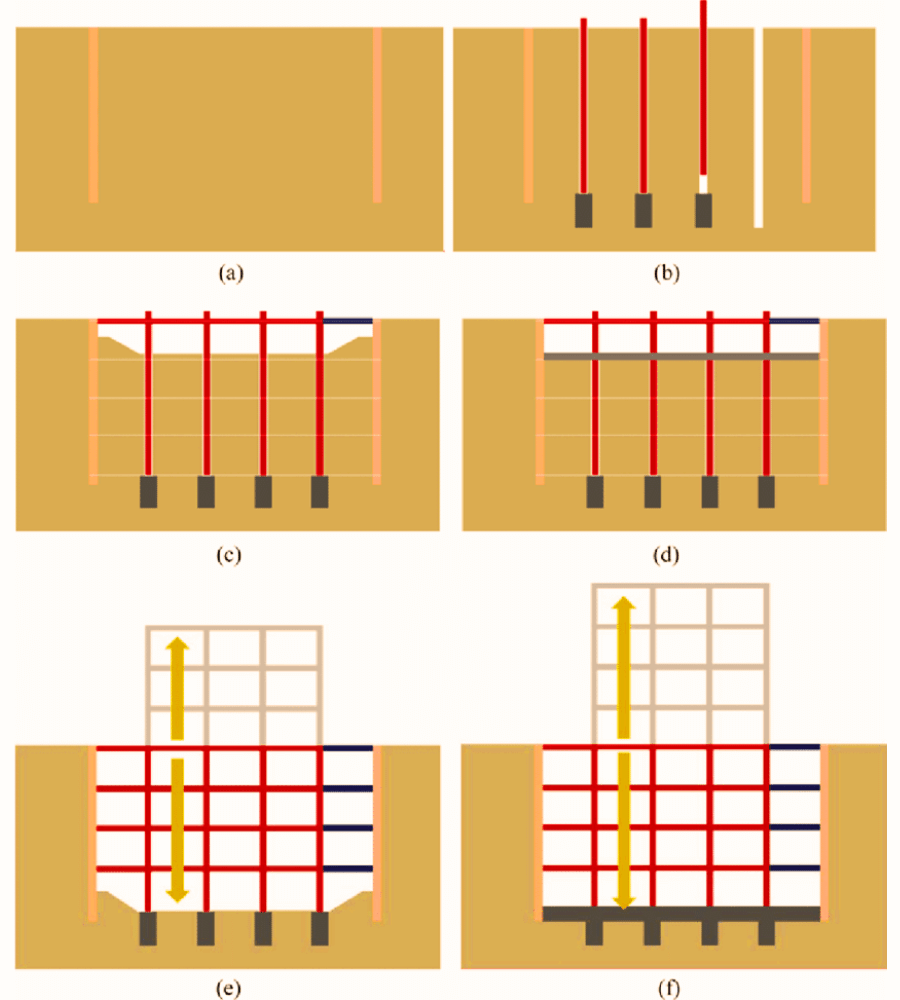Table of Contents
Top Down Construction
The bottom-up method, in which sub-structure and super-structure levels are constructed one after the other, starting from the building’s base and working upward, is frequently used to construct buildings with subsurface structures.
Although the “bottom-up technique,” a traditional method, is simple to plan and implement,
it is impractical for projects with constrained construction time or site constraints (location size, legal problems, etc.). The solution to these challenges is the top-down construction method.
Diaphragm walls (or D walls), which are sometimes referred to as perimeter walls, are a single, secure solution to all the construction-related problems encountered during subsurface construction.
D walls enable excellent earth retention and effective control of groundwater movement.
Its capacity to support superstructure loads makes it possible to apply the superstructure before the building’s substructure is finished.
For deep excavation projects like underground structures, building metro stations, tunnels, etc.,
the top down approach works well when soil movements should be minimized and tieback installation cannot be performed.
What is Top Down Construction Method?
The top down construction method is the reverse of bottom-up construction, which uses extensive excavations to build permanent structures from the top to the basement’s bottom.
In this case, the top down cast retaining wall is supported temporarily by the inside permanent framework.
The higher-level slabs are built before the lower-level slabs because they will serve as horizontal supports for the walls as the excavation moves forward,
A novel method of earth retention that has been gaining acceptance in the building sector is the use of top down construction.

The two main types of urban structures where the top down technique is used are towering buildings with substantial foundations and subsurface constructions like subway stations, parking lots, and underpasses.
Installing a retaining wall is the first step in construction; next, load-bearing components that will support the future superstructure are installed.
Columns for the basement, typically steel beams, are made and installed on the load-bearing members before excavation. Generally, concrete piles or diaphragm wall panels are utilized as load-bearing members.
Top down construction steps

The standard top down construction procedure is as follows:
- Build the integrated retaining wall (usually a diaphragm wall).
- Build the piles and the surrounding wall. Where the piles are being constructed, the steel stanchions must be positioned.
- The first basement level’s floor slab is constructed with an opening so that equipment could be lowered to the level below and excavation waste could be removed—the start of the excavation’s first phase.
- The current pace of superstructure construction must continue.
- Move on to the second excavation step after constructing the second basement-level floor slab.
- Till the necessary depth is attained, repeat the procedure.
- Complete the basement by adding the foundation slab, ground beams, etc.
- Additionally, the superstructure’s construction can be done in accordance with the intended floor and heights.
Advantages of Top down Construction
- The superstructure can be built concurrently with the underground structures to speed up construction.
- When employed for groundwater break, an interim soil retention approach during excavation, and as permanent load-bearing walls for the finished project, concrete diaphragm walls are more cost-effective than other wall types.
- Temporary support is replaced with permanent slabs.
- Since the roof can be cast on a prepared grade without bottom forms, construction may be done quickly and affordably.
- In order to support excavation, the structural slab serves as internal bracing, which reduces the requirement for tiebacks.
- Operating with almost no vibration reduces ground movement, which results in settlement.
- When compared to conventional building, this style of construction requires a smaller excavation width. Consequently, the expense and pollutants are decreased.
- It provides the wall with a strong support system, which minimizes movement.
- There is no requirement to support nearby constructions.
Disadvantages of Top Down Construction
- The excavation and the substructure construction must move more slowly and at an increased cost due to the restrictions set on the plant’s size and the limited access. It is challenging to apply waterproofing on the wall’s outer surface.
- It is difficult to apply waterproofing on the exterior of the walls.
- There is a chance that water will leak out at the joints.
- It could be required to leave gaps in the slabs to allow for future excavation.
- The connections become more challenging as you descend to the foundation slabs, floors, and roofs.
- The excavation is difficult to access, and there isn’t enough space to lay a foundation slab.
- The permanent slabs require some vertical support in the process.
- The permanent structure could support larger loads since the construction became stiffer throughout the transitional phases.
- The layout is complex.
FAQs
What is the top down method in construction?
The retaining wall is temporarily propped up by the permanent internal structure when constructed in a top-down process refers to top-down construction. The higher-level slabs are built before the lower level to serve as horizontal frames for wall support as the excavation continues.
What is the benefit of top down construction?
In comparison to conventional construction, the Top Down Process approach reduces total structural weight by almost half by maximizing the structural effectiveness of concrete and steel. decrease of steel by 20-30%. Special and general conditions are decreased by lower labor costs and quicker timelines.
What are top-down and bottom-up construction?
The “top-down” approach provides for minimum building acquisition, traffic control, or destruction during construction while still allowing excavation to proceed in densely populated regions. The bottom-up method includes developing the structure from the ground level of the building up, as the name suggests.
Why is top-down construction used?
The top-down method allows for an early start on construction for combined developments that incorporate a sizable above-ground component. The superstructure can be constructed together with the underground structures to speed up construction work.
Top Down Construction In India
Manyata Tech Park Phases II and IV are the first top-down constructed structures by The MFAR in India. It is a LEED-certified structure that stands out as a model for environmentally friendly construction practices in India’s IT hub.
Also, Read
What is CMU Wall? – CMU Wall Construction – Cinder Block
AAC Blocks – Properties, Advantages, Disadvantages & Laying Process
Building Construction Process Step By Step
Building Estimate In Excel – Importance, Preparation